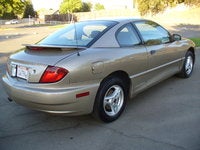Cold air intake
Asked by Phillyboy18 Apr 01, 2012 at 02:55 PM about the 1997 Pontiac Sunfire 2 Dr SE Coupe
Question type: Car Customization
I have a 1997 pontiac sunfire se 2 door coupe with a 2.2 and a 3 speed automatic. I recently built my own custom
cold air intake using a piece together kit from o'reilly auto parts made by spectre. Everything went on perfectly. My
only question is there is a vent or breather of some sort on the right side, or back side, of the valve cover that goes
into the factory air intake right before the air charge meter. how important is it that I have it vent into my new
cold air intake via rubber house like factory or can I just put a small cone filter breather on in place.
11 Answers
aztec626bf answered 12 years ago
This vent is there to draw moisture out of the engine as the oil gets hot. If you don't have this hooked up your oil will retain more moisture and not be as an effective of a lubricant/cleaner for the internal workings of engine. This will vary greatly depending on the type of driving that you do. Lots of short trips bad longer trips better.
aztec626bf answered 12 years ago
I should mention that it's not going to harm your engine in the short term. It will happen over a longer period and it depends on how often you change your oil as well..........
Phillyboy18 answered 12 years ago
If its propose is to remove moisture from the oil a it heats up then why on the "factory" intake would it be recirculated back in to be reburned. Your answer makes absolutely zero sense and makes me doubt that you should even be giving anyone any kind of mechanical knowledge.
aztec626bf answered 12 years ago
Crankcase ventilation was introduced in about 1963. Before that the hydrocarbons and any fumes were ventilated to atmosphere. After that crankcase ventilation was added to cars to burn any hydrocarbons from the crankcase, to relieve crankcase pressure and remove any other gases ie., steam from oil and burn/reburn them. I didn't go into detail before because it was not necessary given the question asked. People that ask questions on here want a straightforward answer that directly relates to their question. It seems people like you just like to argue. You have three mistakes in your statement .....can you find them???
aztec626bf answered 12 years ago
Next time before you challenge me get your facts...................read this is Wikipedia hmmmm sounds like what I said. During normal operation, a small amount of unburned fuel and exhaust gases escape around the piston rings and enter the crankcase, referred to as "blow-by".[7] If these gases had no controlled escape mechanism, the gasketed joints would leak (as they "found their own way out"); also, if the gases remained in the crankcase and condensed, the oil would become diluted and chemically degraded over time, decreasing its ability to lubricate. Condensed water would also cause parts of the engine to rust.[8] To counter this, a crankcase ventilation system exists. In all modern vehicles, this consists of a channel to expel the gases out of the crankcase, through an oil-separating baffle, to the PCV valve, into the intake manifold. In a non-turbo engine, the intake manifold is at a lower pressure than the crankcase, providing the suction to keep the ventilation system going. A turbo engine usually has a check valve somewhere in the tubing to avoid pressurizing the crankcase when the turbo produces boost. If an engine is damaged or enters old age, gaps can form between the cylinder walls and pistons, resulting in larger amounts of blow-by than the crankcase ventilation system can handle. The gaps cause power loss, and ultimately mean that the engine needs to be rebuilt or replaced.[7] Symptoms of excessive blow-by include oil being pushed up into the air filter, out the dipstick,[9] or out the PCV valve. In rare cases of serious piston or ring damage, the oil filter housing's sheet metal can even burst at its seam.
Phillyboy18 answered 12 years ago
You need to get your facts straight because the vent I'm questioning is NOT the pcv. In taking to "professionals" at GM they have informed me that all that vent does is pull vacuum. Completely separate from the pcv. So I would greatly appreciate if you would stop posting on my question. Thank you.
Way to be. Fix it yourself.
You are a clown for trying to do anything to a sissy ass sunfire. They are about as cool as a cavalier. Oh wait they are the same POS. Spend your time and money on something worth adding to rather than this cheap ass girly car. Pretty bad that these rattle straight from the factory. They were made to be cheap ass economical cars, not cool at all! Enjoy your knocking engine.What a waste!
I know i'm 2 years late on that but it needed to be said. Really hope you see...
get rid of the additude, no one appreciates defensive mocking!
I know that this thread is ancient, however, since nobody had correctly answered this I figured I would comment incase anyone else wanted to know. The "Breather Hose" that is being brought into question connects between the aftermarket cold air intake to the side of the valve cover. Its purpose is to recycle any smoke caused by burnt oil in the valve case to be sent back through the exhaust and past the catalytic converter. Basically to help lower emissions. It has no other purpose. Is this a necessity for your car to run? No. Is it a good idea to hook it back up? Yes.
